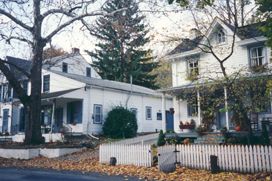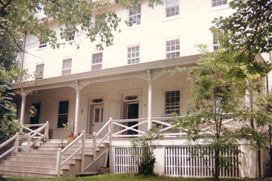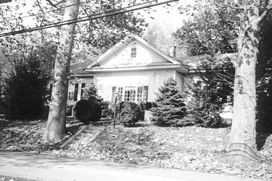
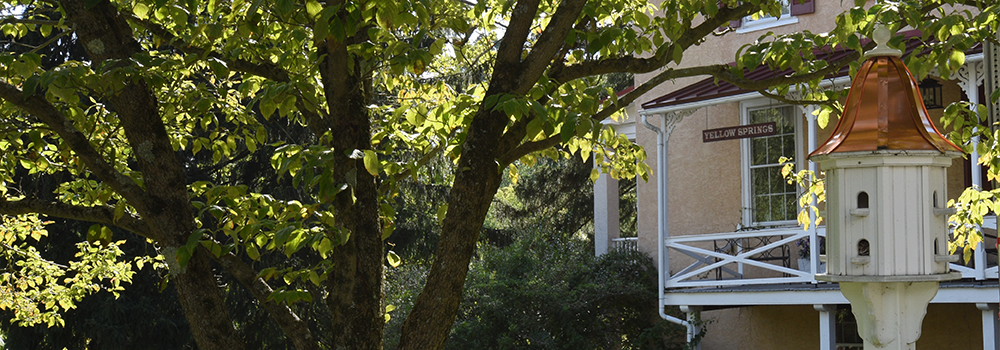
Virtual Tour
Washington Building
Begin your stroll through the village at the beautiful Washington Building. The earliest record of the structure is a permit for use as a tavern in 1750. By the 1760’s, the original log cabin structure had been replaced with additions through 1876. Its name is derived from several visits to the village when George Washington used it as a temporary headquarters.
The building has served as an inn/restaurant/hotel and place of entertainment during both Spa eras (1722-1777 and 1781-1865), a boy’s dormitory and dining room for the Soldiers’ Orphans School (1869-1912), a men’s dormitory and dining room for the Pennsylvania Academy of the Fine Arts Country School (1916-1952), and a food cafeteria and housing for employees of Good News Productions (1952-1974). The building was a restaurant until 2005.
Today Historic Yellow Springs has renovated the building and it is a venue for special events, conferences and classes.
"Mrs. Halman respectfully informs those who wish to partake in the usual harvest celebrations, that she has employed the best musicians, and intends procuring the best liquors, that she is determined nothing shall be wanting to render every accommodation desirable. From the abundance of the present harvest, she has reason to expect that the celebrations will be numerously attended, and is making preparation accordingly."
Advertisement in the American Republican, July 27, 1819.
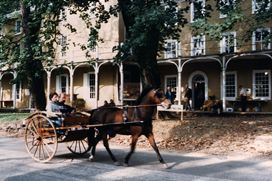
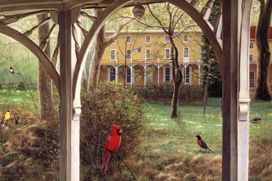
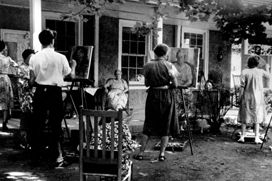
Courtyard / Patio
Strolling back across the road to the Washington Building will bring you to the connection between the village’s two main buildings, former rival hotels.
The Portico, also known as the Piazza, has connected the Inn and the Lincoln Building since 1823 and can be seen in depictions of the village in old advertisements for the Spa. The charming courtyard formed by this connection has always been an important gathering place. Probably its most unique use was during the era of the Pennsylvania Academy of the Fine Arts Country School (1916-1952); the Historic Yellow Springs archives contains numerous photographs of students painting in the Courtyard.
Today the Portico is well-traveled and provides protection from the elements, both sun and rain, during Courtyard programs offered by Historic Yellow Springs, such as Sundaes on Sunday.
"...while the eye is in every direction delighted…with the various tints of vivid green, interspersed with rich and diversified fields of grain – the silvery buckwheat, golden rye, and glittering ranks – with numerous flocks and herds browsing the sun-clad hills, or ruminating beneath umbrageous trees, form a perfection of landscape calculated to gratify the most fastidious taste, and to amuse and charm the most capricious and glowing imagination."
From a series on American Scenery in The Port Folio, 1810.
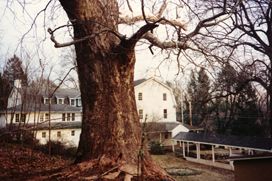
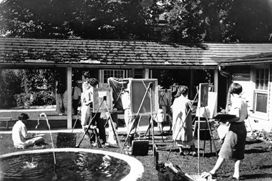
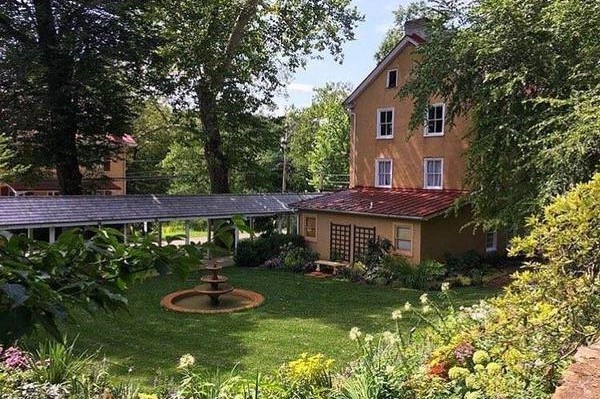
West Meadows
Continue your stroll across the street and down the steps to the west meadows. In Sept. 1777 General Washington and his troops camped beside the creek in these meadows and during both Spa eras (1722-1777 and 1781-1865) they were dotted with bathhouses for visitors coming to the village to “partake of the waters.”
Of the two remaining bathhouses, the gazebo was built in the 1830’s to house the property’s iron spring. The gazebo has come to symbolize Historic Yellow Springs and is the organization’s logo. The other structure, now known as the Poolhouse, was built in 1839 and served as a bathhouse until the Soldiers’ Orphans School turned it into a laundry. It was modified to its present appearance in 1921 by the Pennsylvania Academy of the Fine Arts and contains an open-air spring-fed swimming pool and changing rooms. Today’s visitors enjoy outdoor activities in the meadows just as much as the thousands of visitors preceding them.
"Were the efforts of Art combined with those of Nature, and regulated by the dictates of an improved taste,this highly favoured place would burst upon the enraptured traveler with all the potent charms of magicor enchantment. The bath which is most inviting and consequently most used, is situated in a beautiful vale opposite to, and about two hundred and twenty feet from, the mansion house, at the extremity of a grove of lofty beach trees..."
From a series on American Scenery in The Port Folio, 1810.
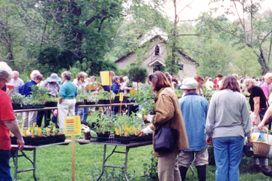
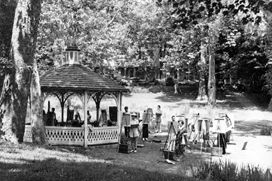
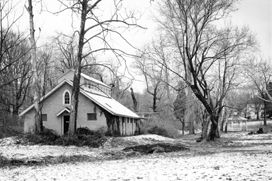
Lincoln Building
Stroll past the courtyard and up the steps to the expansive covered porch of the Lincoln Building. Known as the “Cottage,” the original early nineteenth century hotel building was destroyed by fire and rebuilt in 1899.
As the village changed ownership, the Lincoln Building (re-named during the Country School era, 1916-1952) was used as a girl’s dormitory during the Orphans School period (1869-1912) and again for the Country School. Good News Productions (1952-1974) used it to house its workers as well as produce, edit and view its film productions.
Today the Lincoln Building houses the Historic Yellow Springs administration offices and archives. It is also the home of the Chester Springs Library, a branch of the Chester County Library System, which Historic Yellow Springs helped establish in 1974-75. But most importantly, it serves as the site of most of the organization’s many events and programs.
"Mrs. Holman, of the Yellow Springs Hotel, has erected a large three story House, containing 20 rooms, which is completely finished and furnished with new furniture, and now open for company. It is connected with her former building, by a Piazza, but is in other respects separate, and is entirely free from all culinary and family concerns…and she can now promise the most quiet accommodations to those who may prefer them, with liberty to partake more or less of the amusement of the place."
Advertisement in the National Gazette and Literary Register, July 8, 1823.
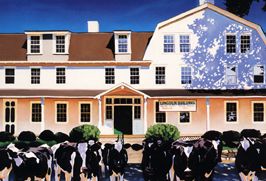
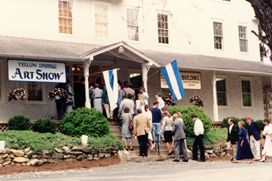
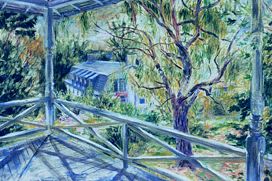
Main House
It’s a short stroll from the Poolhouse to the rear of the Main House, which overlooks the meadows. The foundation of the house dates to the 18th century and the home’s current appearance is c.1840. Variously known as “Our House,” the “Innkeeper’s House” and the “Faculty Building,” it served as the primary residence for the village’s many owners during the second Spa era (1781-1865), the administrators of both the Soldiers’ Orphans School (1869-1912) and the PA Academy of the Fine Arts Country School (1916-1952), and the owner of Good News Productions (1952-1974). The garage was formerly a utility building and power plant.
After the purchase of the village by Historic Yellow Springs in 1974, this house and one other property were sold to private individuals for restoration. Following a major capital campaign, the organization re-purchased the property in 1997. It is now also known as the Rosato House in honor of a major donor. Today it is still used as a residence.
"The “object” of the Academy is to give open-air instruction in the fine arts and especially in the painting and drawing of landscape and to establish an artists’ colony where artists can help each other – thereby affording a splendid opportunity for art students and artists as well."
John Andrews Myers, secretary of the Pennsylvania Academy of the Fine Arts, announcing to members that "the open-air school and artists’ colony" was open for their inspection, spring 1918.
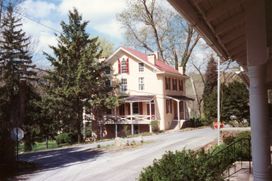
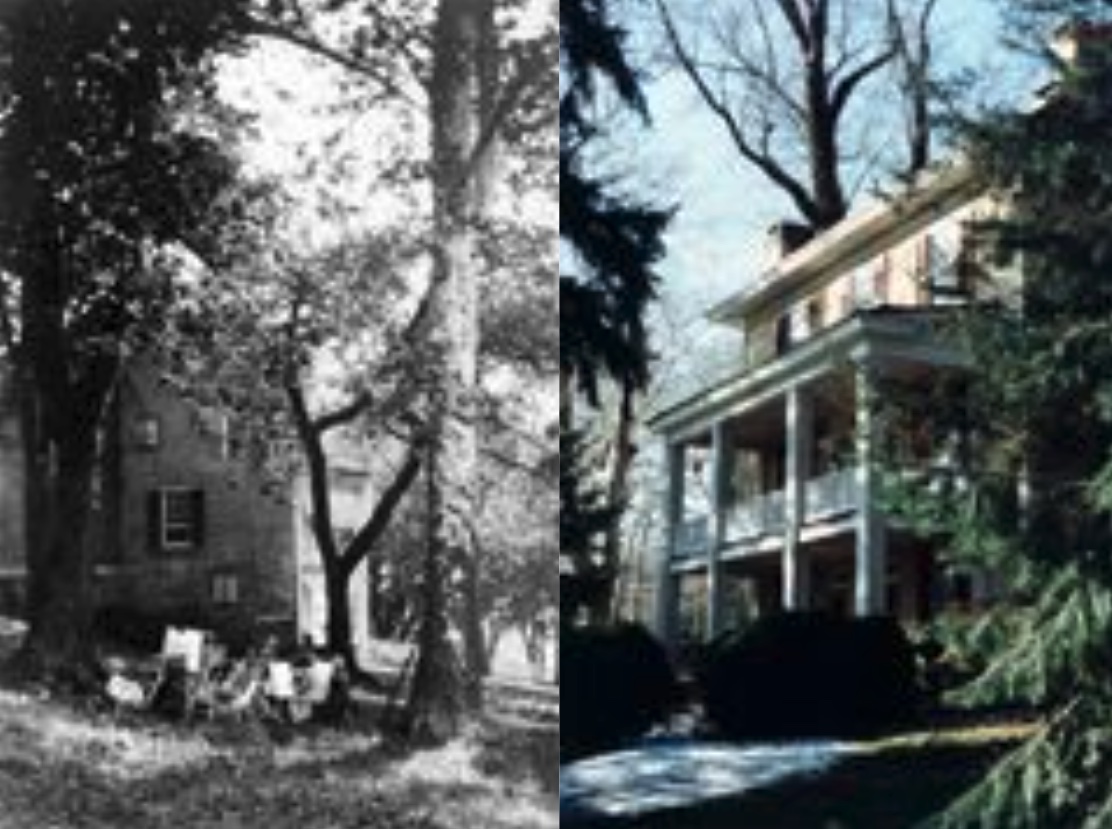
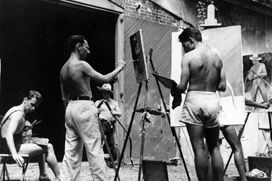
Hospital Ruins & Herb Garden
From the west side porch of the Lincoln Building your stroll takes you up the hillside to the ruins of the Revolutionary War era hospital. The original structure was built in 1777-78 and was the only hospital commissioned by the Continental Congress to be built during the Revolutionary War. Known as Washington Hall, the building housed a spa hotel (1781-1865), classrooms (Soldiers’ Orphans School, 1869-1912), an art studio (Country School, 1916-1952), and a film production studio (Good News Productions, 1952-1974) in subsequent eras.
After a fire in 1902, Washington Hall was rebuilt, but a final fire in 1962 destroyed the site. Historic Yellow Springs stabilized the ruins and the Philadelphia Unit of the Herb Society of America installed an authentic 18th century medicinal herb garden above the site. In 1987, both were dedicated as a Revolutionary War Memorial during the “We the People 200” celebration of the 200th anniversary of the Constitution.
"As usual I was ‘packed’ in wet sheets early this morning for about two hours, when I perspired freely, under the warm influences of sundry blankets comforts and a feather bed, – all pressed and squeezed tight and close around me. Upon rising, or rather upon being raised up from this vapour bath, I walk to a deep very cold plunge bath, – when I suddenly am stripped of my blankets, and then instantly jump into the water, head foremost..."
July 19, 1847, letter from a patient, John Knight, to his wife describing his treatment at the refurbished old hospital building.
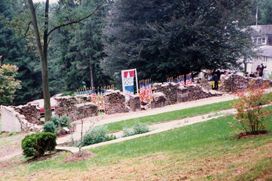
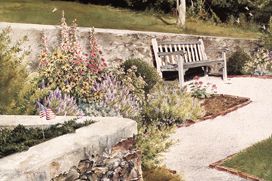
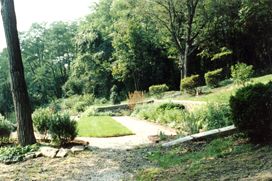
Chester Springs Studio
Chester Springs Studio, originally a barn used as a livery stable through the turn of this century, dates to the eighteenth century. In 1921, the Pennsylvania Academy of the Fine Arts converted it to a studio for use by students at its Country School. Known as the Small Barn Studio, it is still easily recognizable by its distinctive skylight.
The original founders of Historic Yellow Springs hoped to foster cultural and artistic activities in the village. To that end, Chester Springs Studio, a new non-profit visual arts organization, was formed and Historic Yellow Springs sold them the Small Barn Studio and two acres in 1976.
As of 2007, Historic Yellow Springs and the Chester Springs Studio have merged again into one organization. Today the Studio continues to offers art classes, artists’ residencies, and exhibitions in the barn as well as in the old Post Office across the road.
"The chief object of the Academy in establishing a school in the country is to afford fine-art instruction in the open air, with all the beautiful surroundings of nature herself, in order to supplement instruction within the walls of classrooms, and to afford an opportunity, for the study of art in the summer, to school teachers and to others who cannot spare time to study in the winter."
The School Circular, 1917
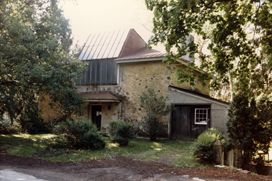
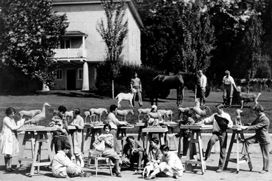
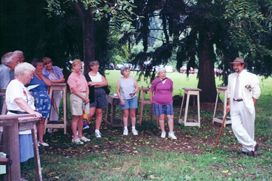
East Meadows
Stroll down the hill and across the old tennis court behind the Studio to the path entering the garden portion of the East Meadows. In the late 1980’s/early 1990’s Historic Yellow Springs reconstructed the “Oriental Bog Gardens” originally installed in the 1920’s to provide inspiration and subject matter for students at the Country School. The restoration of two historic springhouses was also part of the project.
The 1830’s Jenny Lind Springhouse was named after a visit from the “Swedish Nightingale” in 1850. Legend has it that she was lowered into the pool on a swing during a private bathing session.
The Crystal Diamond Springhouse, c. 1840, houses a magnesium spring whose waters are crystal clear and sparkle like diamonds. It has a unique diamond shaped pool as well as a diamond shaped opening in the roof. The interior of both springhouses can be viewed through openwork iron doors. A wood chip path leads you through the lush gardens.
"Of the various watering places and rural retreats which invite the languid, the listless, or the laborious citizen to invigorate his system, to relax from the fatigues of business, or to restore his declining health, none certainly combines so many advantages as this delightful spot. Its proximity to the city, the salubrity of the air, the purity of the water, the coldness and clearness of the bath, the fertility of the soil, and the variegated scenery which surrounds it, all conspire to charm the senses, and to sooth, and exhilarate the mind."
From a series on American Scenery in The Port Folio, 1810
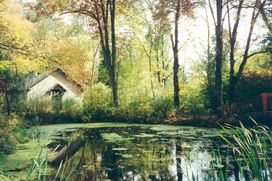
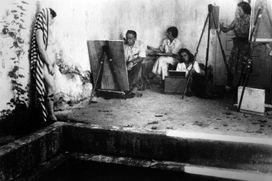
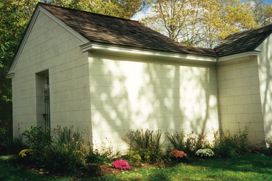
Yellow Springs Cultural Center
Stroll northward through the meadow to the Yellow Springs Cultural Center. The original barn was built in 1845 and has been through several phases of adaptive restoration. In the 1920’s the PA Academy of the Fine Arts converted it to studio space for its Country School students and it was known as the Sculptors’ Studio.
In the 1950’s Good News Productions added a sound and film studio in the loft. The Yellow Springs Institute, a non-profit performing arts organization, was formed in 1976 and purchased the barn and five acres from Historic Yellow Springs. They converted the loft to a black box theatre (1982) and added a conference center (1989).
Historic Yellow Springs was able to re-purchase the property in 1997 and created the Yellow Springs Cultural Center. In 1998 extensive improvements were made in memory of George Congdon, long-time Yellow Springs Board member. In 2005, West Pikeland Township purchased the building to use as their new headquarters.
"Chester Springs was a Shangri-la and the Sculpture Barn was like a cathedral, with great north light – the three-dimensional lighting that you needed."
Celebrated sculptor Angelo Frudakis in an interview at Historic Yellow Springs, Sept. 1997
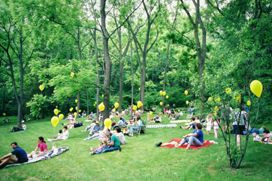
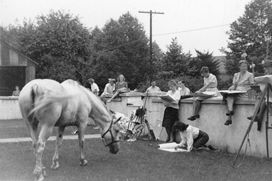
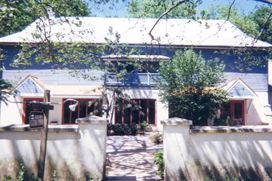
Other Buildings
Connie’s House dates to the late 1800’s and was originally a post office and general store. It is now owned by the Chester Springs Studio and is used for exhibitions and artists’ residencies. The building was given to the Studio by Yellow Springs Founder Connie Fraley, hence the affectionate name. The Vaughn House, named for its last resident, is a charming small farmhouse built in the 1830’s. Historic Yellow Springs completely restored the house in 1989 and it serves as a tenant residence.
Mrs. Holman, the retiring owner of the Yellow Springs Spa property, built the Jenny Lind House in the early 1840’s as a boarding house – it has eight bedrooms!
The Yeaworth House, also named for its last resident, was built in 1899 as an infirmary for the Soldiers’ Orphans School. It was converted to a residence in the 1950’s, extensively renovated in 1987-88, and now serves as another tenant residence.
The English actress Fanny Kemble describing her visit to Yellow Springs during July 1843 in her book Records of Later Life, 1882:
"This morning the children took me up a hill which rises immediately at the back of the house (the Jenny Lind House), on the summit of which is a fine crest of beautiful forest trees, from which place there is a charming prospect of hill and dale, a rich rolling country in fine cultivation – the yellow crops of grain, running like golden bays in the green woodland that clothes the sides and tops of all the hills, the wheat, the grass, the variegated patchwork covering of the prosperous summer earth."
